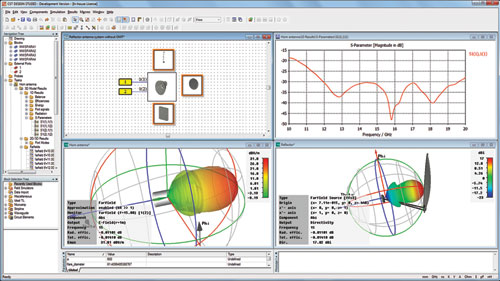

- CST MICROWAVE STUDIO TUTORIAL ANTENNA DESIGN PATCH
- CST MICROWAVE STUDIO TUTORIAL ANTENNA DESIGN SOFTWARE
- CST MICROWAVE STUDIO TUTORIAL ANTENNA DESIGN LICENSE
The software may be used only in accordance with the terms of those agreements.
CST MICROWAVE STUDIO TUTORIAL ANTENNA DESIGN LICENSE
The software described in this document is furnished under a license agreement or non-disclosure agreement. Information in this document is subject to change without notice. In conclusion, a good designer should be able to use different CAD tools with deep understand of limits of their numerical techniques and modeling interface.Copyright CST 1998-2010CST Computer Simulation Technology AGAll rights reserved. The part of FEKO which is based on GTD cannot be replaced by Zeland, HFSS or CST beacuse it is mainly suitable for large strucutures like reflector antennas. Thus, the FEKO suite provides a versatile set of tools, offering time-efficient and accurate solutions for a variety of EM problems. FEKO has two main solvers, one is based on MoM and another based on GTD. At the same time, the FEKO suite is capable of hybrid simulations mixing the CEM codes. Luckily, the FEKO electromagnetic computational suite provides various computational electromagnetic (CEM) techniques, including MoM, FEM, MLFMM, PO, GO, and UTD, in a single package. However, for complicated geometery, you may find the accuracy od HFSS and CST are much better than IE3Dĭue to the approximations which you have to do in the geometery of the structure. In this case the result of Zeland IE3D is the more accurate result.
CST MICROWAVE STUDIO TUTORIAL ANTENNA DESIGN PATCH
Thus for regular shapes like rectangular patch antenna you may obtain slight difference between HFSS and Zeland IE3D.

The accuracy of Finite Element is slightly less than the accuracy of MoM. The advantage of CST is that within on run one can obtain the results on a wide band because it starts in time domain and convert the results to FD via Fourier Transform.ĭifferent opetions are found in HFSS, but it is still FD solution. HFSS is based on Finite Element method and CST is based on a method which is similar to FDTD.īoth techniques are still suitable for small or moderate objectes compared with the operating wavelength. It is also mainly suitable for regular shapes like cylinderical DRA as an example.īoth MoM and FDTD are not suitable for large antenna structures like reflector antenna or large antenna arrays.Īnsoft HFSS and CST have much better interface which enable te user to include very fine details in the geometery of simulated structure. It is based on combination of specific geometeries. On the other hand ZELAND Fidelty, is based on FDTD(Finite Difference TimeDomain) analysis. Thus, if the structue is simple like rectangualr or circular, IE3D would be the best. However, the interface of IE3D is not quite suitable to include very fine details on the geomtery of the structure. It depends mainly on the geomtery of the structure and the required accuracy of the solution.įor example ZELAND IE3D is based on MoM(method of moments) solution of integral equation which has an excellent accuracy for frequency domain analysis. What are some good software tools for antenna. The System Assembly and Modelling framework in CST DS allows the user to set up coupled simulations which can combine different solvers automatically by making use of field sources.įinally, powerful automated post-processing allows you to extract every magnitude of interest for an antenna designer – nearfield plots, SAR, phase center, directivity or farfield gain for single antennas or arrays - and to process those data further for use in parameter sweeps or optimizations in order to improve the performance of your design. Installation of an antenna in a device or on a platform makes its analysis even more complex. CST DESIGN STUDIO ™ (CST DS) allows the hybrid co-simulation of the effect of an attached circuit on the antenna performance. The transient solver could be best for wideband or planar antennas, the frequency domain solver may be more suitable for electrically small antennas, while the integral equation solver can efficiently simulate electrically large or wire antennas.Īntennas never operate in isolation, but are attached to a feed network. The range of simulation methods in CST MWS allows the engineer to choose the best technique for each application. CST provides a variety of tools for each stage of the antenna design flow to study and improve your design.Īntennas are used in a vast variety of applications, and thus take come in a vast variety of form factors and radiation mechanisms. They are the indispensable link between the contained signal and the “ether”. Antennas are essential wherever wireless communication required.


 0 kommentar(er)
0 kommentar(er)
